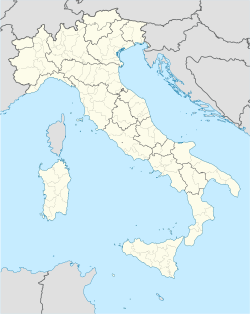Sarzana
| Sarzana | |
|---|---|
| Comune | |
| Città di Sarzana | |
| 250px | |
| Location of Sarzana in Italy | |
| Coordinates: Lua error in package.lua at line 80: module 'strict' not found. | |
| Country | Italy |
| Region | Liguria |
| Province / Metropolitan city | La Spezia (SP) |
| Frazioni | Marinella di Sarzana, Falcinello, Sarzanello, San Lazzaro |
| Government | |
| • Mayor | Alessio Cavarra (from 2013) |
| Area | |
| • Total | 34 km2 (13 sq mi) |
| Elevation | 21 m (69 ft) |
| Population (30 November 2010) | |
| • Total | 21,978 |
| • Density | 650/km2 (1,700/sq mi) |
| Demonym(s) | Sarzanesi |
| Time zone | CET (UTC+1) |
| • Summer (DST) | CEST (UTC+2) |
| Postal code | 19038 |
| Dialing code | 0187 |
| Patron saint | St. Andrew |
| Saint day | November 30 |
| Website | Official website |
Sarzana (Italian pronunciation: [sarˈdzaːna]) is a town and comune in the Province of La Spezia, of Liguria, Italy, 15 kilometres (9 mi) east of Spezia, on the railway to Pisa, at the point where the railway to Parma diverges to the north. In 2010 it had a population of 21,978.
Contents
History
The position of Sarzana at the entrance to the valley of the Magra (ancient Macra), the boundary between Etruria and Liguria in Roman times, gave it military importance in the Middle Ages. The first mention of the city is found in 983 in a diploma of Otto I; in 1202 the episcopal see was transferred from the ancient Luni, 5 kilometres (3 mi) southeast, to Sarzana.
Sarzana, owing to its position, changed masters more than once, belonging first to Pisa, then to Florence, then to the Banco di S. Giorgio of Genoa and from 1572 to Genoa itself.
These changes left in Sarzana a conspicuous fortress, which remains a focus of attraction for people interested in military history and specifically in the history of fortifications (see Star fortress).[1]
In 1814 it was assigned to the Kingdom of Sardinia, the frontier between Liguria and Tuscany being now made to run between it and Carrara.
Sarzana was the birthplace of Pope Nicholas V in 1397.
A branch of the Cadolingi di Borgonuovo family, Lords of Fucecchio in Tuscany from the 10th century onwards, which had acquired the name of Buonaparte, had settled near Sarzana before 1264. In 1512 a member of the family (Francesco Buonaparte, who died in 1540) permanently took up residence in Ajaccio, becoming the founder of the Corsican line of Buonapartes and hence a direct forebear of Sebastiano Nicola Buonaparte. He in turn was the great-grandfather of the emperor Napoleon I (who was born in Corsica in 1769).
In 1921 Sarzana was the seat of fights between the population and Fascist squads (Italian: Fatti di Sarzana). During them, a small group of Carabinieri and, alter, simple citizens opposed and pushed back some 300 armed Fascists who had come to devastate the town, killing some of them. During the German occupation of Italy in World War II, Sarzana was a center of partisan resistance.[2]
Main sights
- Sarzana Cathedral: a white marble Gothic-style church built 1355–1474. It houses two elaborately sculptured altars of the latter period.
- Citadel of Sarzana; former citadel built by Pisans, was demolished and re-erected by Lorenzo de' Medici.
- Castle of Sarzana: located on the hill of Sarzanello, at the site of fortress from as early as emperor Otto I. The castle was rebuilt or enlarged by the condottiero Castruccio Castracani, and later became the residence of the bishops of Luni.
- Pieve of Sant'Andrea: 10th-11th century parish church, and rebuilt in 1579, and has 16th-century portal. It houses 14th-15th century marble statuary, a Vocation of Saints by Domenico Fiasella, and a dodecagonal baptismal font.
- San Francesco: documented from 1238 and, according to tradition, founded by St Francis himself. It houses the funerary monument (1328) of Castruccio Castracani's son, by Giovanni di Balduccio; the tomb of bishop Bernabò Malaspina; and a frescoed lunette attributed to Priamo della Quercia.
- Palazzo del Capitano: designed by Giuliano da Maiano (1472), but now entirely altered.
International relations
Sister cities / twin towns
Climate
The Köppen Climate Classification subtype for this climate is "Csb"(Mediterranean Climate).[3]
References
 This article incorporates text from a publication now in the public domain: Lua error in package.lua at line 80: module 'strict' not found.
This article incorporates text from a publication now in the public domain: Lua error in package.lua at line 80: module 'strict' not found.- Cathedral of Sarzana
- ↑ Harris, J., "Sarzana and Sarzanello - Transitional Design and Renaissance Designers", Fort (Fortress Study Group), No. 37, 2009, pp. 50-78
- ↑ Lua error in package.lua at line 80: module 'strict' not found.
- ↑ Climate Summary for Sarzana, Italy
| Wikimedia Commons has media related to Lua error in package.lua at line 80: module 'strict' not found.. |

